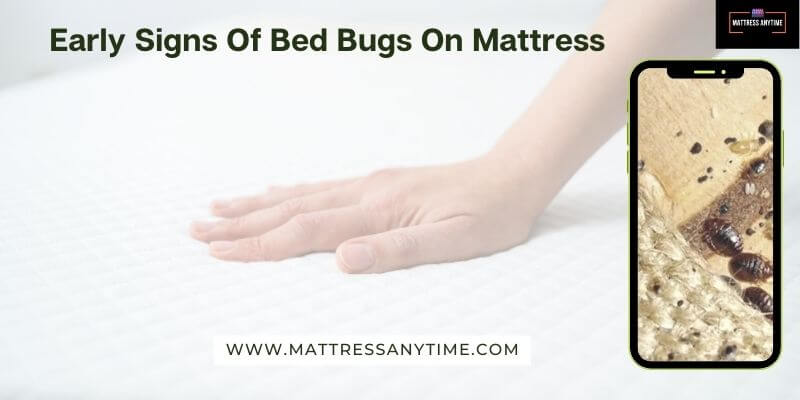Last Updated on September 14, 2023 by nilSSidhajag
Where to Look for Bed Bugs on Mattress? To look for bed bugs on a mattress, first, remove all the sheets and blankets. Then, inspect the top, bottom, and sides of the mattress for any signs of bed bugs. Look for small brown spots that may be blood stains, as well as small white eggs.
If you see any of these signs, then there is a good chance that your mattress is infested with bed bugs.
Most people don’t realize that bed bugs can be found in many different places other than just your bed. These pests are experts at hiding and can be found in any cracks or crevices in your home. But if you suspect you have an infestation, your mattress is a good place to start looking for evidence of these critters.
Here are some tips on where to look for bed bugs on your mattress:
- Check the seams of your mattress for any brown or red stains. This could be bed bug excrement or blood from a crushed bug.
- Take a close look at the tufts and folds of your mattress fabric. Bed bugs like to hide in tight spaces, so these areas are prime real estate for them.
- 3. If you have a removable mattress cover, take it off and inspect the surface of the mattress itself.
Again, look for any signs of staining that could indicate the presence of bed bugs.
No Signs Of Bed Bugs But I Have Bites
If you have bites but no signs of bed bugs, it’s possible that another type of insect is to blame. If you live in an area where bed bugs are common, it’s important to be vigilant and inspect your home regularly for these pests. However, there are a few other insects that can bite humans and cause similar symptoms. Here are some examples:
Mosquitoes:
- Mosquitoes are one of the most common biting insects in the world.
- They can transmit diseases like Zika and West Nile virus, so it’s important to protect yourself from them when spending time outdoors.
- Bed bug bites usually appear as small, red bumps that are clustered together in a small area.
- If you have mosquito bites, they will likely be more widespread and may also include swelling and itching.
Fleas:
- Flea bites often look similar to bed bug bites and can be just as itchy and annoying.
- These pests feed on the blood of animals (including humans), so if you have pets, they may be bringing fleas into your home without you realizing it.
- Inspect your pets regularly for fleas and treat them with a suitable product if necessary.
Early Signs Of Bed Bugs On Mattress

When it comes to bed bugs, the early signs are often hard to spot. These pests are experts at hiding, and their small size makes them difficult to see with the naked eye. But there are some telltale signs that can alert you to their presence.
Here are some early signs of bed bugs on mattress:
1. Bloodstains on your sheets or pillowcases. Bed bug bites can cause small, red welts on your skin. If you notice these welts after waking up in the morning, it’s a good sign that bed bugs may be present in your home.
2. Tiny black spots on your mattress or box spring. These spots are actually bed bug feces, and they’re a surefire sign that these pests have taken up residence in your bedroom.
3. A sweet, musty smell comes from your mattress or bedding. This is another sign of bed bug activity, as the insects emit an odor that has been described as similar to spoiled raspberries. If you notice any of these signs, it’s important to take action immediately and call a professional pest control company for assistance.
How To Get Rid Of Bed Bugs
- If you think you have bedbugs, it’s important to find them early and get rid of them. Bedbugs are small insects that feed on human blood. They’re usually active at night when people are asleep.
- Bedbugs are a problem in many homes and apartments. They can be hard to get rid of, but it’s important to do so because they can cause skin irritation and other health problems.
- The best way to find bedbugs is to look for them at night when they’re most active.
- Use a flashlight to look for small, brown bugs in your sheets and mattress.
- Also check behind picture frames, in cracks in furniture, and in any other dark places where bed bugs might hide during the day.
- If you see bed bugs, don’t try to kill them yourself, you could end up spreading them around your home.
- Instead, call a professional pest control company to come and take care of the problem for you.
How Long Before I Know If I Brought Bed Bugs Home
If you think you’ve brought bed bugs home with you, don’t panic. It can be difficult to tell for sure if you have bed bugs, but there are a few things you can do to check.
First, look for signs of bedbugs in your bedroom. Check the sheets and mattress for small brown spots (this could be bed bug droppings). If you see any live bedbugs, they’ll be small (about the size of an apple seed), dark brown, and flat. You might also notice small bites on your skin that are red and itchy.
If you suspect you have bed bugs, there’s no need to call an exterminator right away. There are a few things you can do to try to get rid of them yourself. Start by vacuuming your entire bedroom, including under the bed thoroughly. Then wash all of your linens in hot water.
You can also try placing items like luggage or furniture in a sealed plastic bag and putting them in the freezer for a few days, this will kill any bedbugs that may be hiding inside.
How To Check For Bed Bugs With Flashlight
Bedbugs are small, reddish-brown insects that feed on the blood of animals and humans. They are often found in mattresses, bedding, and furniture. Bed Bugs are difficult to see with the naked eye and can be mistaken for other insects, such as carpet beetles or cockroaches.
To check for bedbugs, you will need a flashlight and a magnifying glass. Look for small, dark spots on your mattress or bedding. These spots may be bed bug fecal matter or blood stains from crushed bedbugs.
If you see any of these signs, it’s time to start looking for live bedbugs. Begin by stripping your bed of all linens and clothing. With a flashlight in hand, thoroughly inspect every inch of your mattress, paying close attention to seams, tufts, and folds.
Use the magnifying glass to get a closer look at potential bugs or eggs. Don’t forget to check behind headboards and along baseboards too, bedbugs can hide anywhere. If you think you’ve found a bedbug, carefully pick it up with tweezers (or use sticky tape) and place it in a sealable container like a zip-top bag.
How Do You Check A Mattress For Bed Bugs?
If you think you might have bed bugs, the first thing to do is check your mattress for signs of pests. Here’s how to conduct a thorough inspection:
- Start by stripping your bed of all sheets, blankets, and pillowcases. If you suspect that your bedding may be infested with bed bugs, wash it on the hottest setting possible and dry it on high heat as well. Alternatively, you can seal contaminated items in plastic bags and place them in the freezer for at least 24 hours to kill any live insects.
- Once your bedding is removed, take a close look at the mattress itself. Look for any dark spots or stains that could be dried blood from crushed bugs. Also, inspect the seams and tufts of the mattress for small brownish-red insects. Bed bugs are typically about 1/4 inch long, so they may be difficult to spot with the naked eye. If you’re unsure whether what you’re seeing is a bed bug or something else, use a magnifying glass for a closer look.
- Pay special attention to the area around your headboard since this is where bed bugs are most likely to congregate.
Where Do Bed Bugs Live On The Mattress?

Bed bugs are small, parasitic insects that feed on the blood of humans. They are reddish-brown in color, oval in shape, and about the size of a poppy seed. Bed bugs typically live in mattresses, bed frames, and headboards where they have easy access to their human hosts.
However, they can also live in other furniture such as chairs, couches, and dressers. When feeding, bed bugs insert their long beak into their host’s skin and withdraw blood through hollow tubes. This process is usually painless and takes about five minutes.
After feeding, bed bugs return to their hiding place to digest their meal. Bed bug bites are often not felt by the person being bitten and may go unnoticed for days or even weeks. However, some people do experience itching, swelling, and redness at the site of the bite.
If you think you may have been bitten by a bed bug, it is important to inspect your mattress and furniture for signs of these pests.
How Do You Find Bed Bugs During the Day?
When looking for bedbugs during the day, it is important to check all of the places where they might be hiding.
- This includes mattresses, box springs, headboards, bed frames, and any other furniture in the room.
- It is also important to look for signs of bedbugs such as small stains or smears of blood on sheets and pillowcases.
- If you see any of these signs, it is likely that there are bedbugs present.
- To confirm the presence of bedbugs, you can try using a flashlight to look for them in their hiding spots.
- Bed Bugs are small, brownish-red insects that are about the size of an apple seed.
- They are most active at night when they come out to feed on their human hosts.
However, they can also be active during the day if there is a food source available.
Summary
If you’re concerned that you might have bed bugs in your home, one of the first places you’ll want to check is your mattress. Here’s a quick guide on where to look for bed bugs on your mattress, and what to do if you find them. Start by checking the seams of your mattress for any signs of bed bug activity.
If you see anything suspicious, it’s time to start looking more closely. Check the folds and tufts of your mattress for bed bugs. They like to hide in these dark, tight spaces. Pay close attention to the area around the headboard, as this is a common spot for them to congregate. Finally, flip your mattress over and check the underside.
Bed bugs can also be found here, often near the box spring. If you do find bedbugs on your mattress, don’t panic. There are steps you can take to get rid of them and prevent them from coming back. Be sure to wash all of your bedding in hot water and vacuum both sides of your mattress thoroughly.



